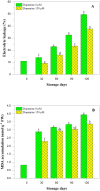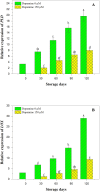Exogenous dopamine application ameliorates chilling injury and preserves quality of kiwifruit during cold storage
- PMID: 39843929
- PMCID: PMC11754593
- DOI: 10.1038/s41598-025-87542-2
Exogenous dopamine application ameliorates chilling injury and preserves quality of kiwifruit during cold storage
Abstract
This study investigated the mechanisms employed by exogenous dopamine application in alleviating chilling injury in kiwifruits during storage at 1 °C for 120 days. Our results indicated that dopamine treatment at 150 µM alleviated chilling injury in kiwifruits during storage at 1 °C for 120 days. By 150 µM dopamine application, higher SUMO E3 ligase (SIZ1) and target of rapamycin (TOR) genes expression accompanied by lower poly(ADP-Ribose) polymerase 1 (PARP1) and sucrose non-fermenting 1-related kinase 1 (SnRK1) genes expression was associated with higher salicylic acid, ATP, NADPH and proline accumulation in kiwifruits during storage at 1 °C for 120 days. In addition, higher 2,2-diphenyl-1-picrylhydrazyl (DPPH) scavenging capacity arising from higher phenols and flavonoids accumulation in kiwifruits treated with 150 µM dopamine could be ascribed to higher phenylalanine ammonia-lyase (PAL) enzyme activity. Additionally, lower endogenous hydrogen peroxide (H2O2) accumulation along with higher ascorbic acid accumulation in kiwifruits treated with 150 µM dopamine could be attributed to lower superoxide dismutase (SOD) along with higher catalase (CAT) enzymes activity. Moreover, lower phospholipase D (PLD) and lipoxygenase (LOX) genes expression in kiwifruits treated with 150 µM dopamine was accompanied with membrane integrity preservation as evidenced by lower electrolyte leakage and malondialdehyde (MDA) accumulation. Therefore, exogenous dopamine could be employed as a potential technique for alleviating chilling injury in kiwifruits during cold storage.
Keywords: Chilling injury; DPPH scavenging capacity; Dopamine; Kiwifruit; Membrane integrity.
© 2025. The Author(s).
Conflict of interest statement
Declarations. Competing interests: The authors declare no competing interests.
Figures







References
-
- Guo, W. et al. Endogenous salicylic acid mediates melatonin-induced chilling-and oxidative-stress tolerance in harvested kiwifruit. Postharvest Biol. Technol.201, 112341 (2023).
-
- Jiao, C. IP3 mediates NO-enhanced chilling tolerance in postharvest kiwifruit. Postharvest Biol. Technol.176, 111463 (2021).
-
- Jiao, J. et al. Application of melatonin in kiwifruit (Actinidia chinensis) alleviated chilling injury during cold storage. Sci. Hortic.296, 110876 (2022).
-
- Liu, Q. et al. Yang, Z. γ-Aminobutyric acid treatment induced chilling tolerance in postharvest kiwifruit (Actinidia chinensis cv. Hongyang) via regulating ascorbic acid metabolism. Food Chem.404, 134661 (2023). - PubMed
-
- Antunes, M. D. C. & Sfakiotakis, E. M. Changes in fatty acid composition and electrolyte leakage of ‘Hayward’ kiwifruit during storage at different temperatures. Food Chem.110, 891–896 (2008). - PubMed
MeSH terms
Substances
LinkOut - more resources
Full Text Sources
Miscellaneous

